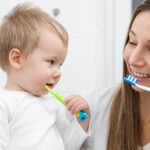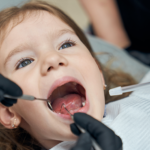Children’s dental health is vital for their holistic wellness, encompassing protection from tooth decay and damage necessitating dental restoration. Specifically tailored to children’s smaller oral anatomy, pediatric crowns are tooth-shaped caps, such as resin-veneered stainless steel, zirconia ceramic, or heat-molded plastic, effectively shielding and restoring decayed or damaged teeth to ensure healthy growth and development.
Types of Pediatric Crowns
When it comes to restoring children’s teeth, various dental crown options are available to address different needs and preferences. Below are the four primary types of pediatric dental crowns, each designed to provide effective solutions for young patients:
-
-
Stainless-Steel Crowns
Stainless steel crowns are the most commonly used type for pediatric teeth restoration. They are silver caps that cover the entire tooth, providing excellent durability and longevity. Stainless steel crowns are used for both primary (deciduous) and permanent teeth, and they are suitable for both anterior (front) and posterior (back) teeth. These crowns are pre-formed and can be easily adapted to fit the child’s tooth using dental cement.
-
Resin-Veneered Stainless Steel Crowns
Resin-veneered stainless steel crowns combine the strength and durability of stainless steel with improved aesthetics. These crowns have a tooth-colored resin veneer on the front, making them more visually pleasing. Resin-veneered stainless steel crowns are popular for restoring anterior teeth in children, where aesthetics is a concern.
-
Zirconia Ceramic Crowns
Zirconia ceramic crowns are a popular choice for restoring anterior and posterior teeth in children. They offer excellent esthetics and durability, making them an ideal choice for children who need both functional and visually appealing crowns. Zirconia crowns are made from zirconium oxide, a biocompatible material that is safe for pediatric tooth restorations.
-
Heat-Molded Plastic Crowns
Heat-molded plastic crowns are made with a clear shell and a tooth-colored inside. They are mainly used for anterior tooth restoration in toddlers and young children. Heat-molded plastic crowns are cost-effective and aesthetically pleasing, making them a suitable choice for temporary tooth restoration.
-
When are Pediatric Crowns Used?
Pediatric crowns are used in various situations, including:
-
-
- Severe tooth decay: When a child’s tooth decay is extensive and cannot be effectively treated with fillings, a crown may be necessary to restore and protect the tooth.
- Fractured or chipped teeth: When a child’s tooth is fractured or chipped, a crown can be used to restore the tooth’s structure and protect it from further damage.
- Pediatric tooth restoration: Pediatric crowns are used in the restoration of primary (deciduous) teeth, ensuring proper function and aesthetics until the permanent dentition emerges.
- Tooth cap after tooth removal: After a tooth extraction, a pediatric crown can be placed to maintain the space and prevent future alignment issues.
-
Advantages of Pediatric Crowns
Pediatric crowns offer several advantages, making them an excellent choice for children’s dental restoration:
-
-
- Protection and stability: Crowns provide exceptional protection to decayed or damaged teeth, preventing further deterioration and potential pain or infection.
- Aesthetics: Resin-veneered stainless steel and zirconia ceramic crowns offer excellent esthetics, allowing children to smile confidently.
- Durability: Stainless steel and zirconia crowns are highly durable, making them a long-lasting solution for children’s teeth.
- Cost-effectiveness: Stainless steel and heat-molded plastic crowns are cost-effective options, providing excellent value for money.
-
Pediatric Crown Procedure
The pediatric crown procedure involves several steps:
-
-
- Tooth preparation: The damaged or decayed tooth is first cleaned and prepared for the crown placement. This may involve removing decayed or weakened tooth structure.
- Crown placement: The appropriate crown is selected based on the child’s needs and oral anatomy. The crown is then fitted onto the tooth using dental cement.
- Bite adjustment: After the crown is placed, the child’s bite is checked and adjusted if necessary to ensure proper occlusion.
- Follow-up care: Regular dental check-ups and oral hygiene practices are essential for maintaining the crown’s integrity and the child’s overall dental health.
-
To explore further about the exceptional pediatric dental care Madison Dentistry offers and to determine the suitability of the pediatric crown procedure for your child, we encourage you to arrange a consultation with us. Embark on the journey toward ensuring your child’s vibrant smile by reaching us at 973-822-8003 today.




